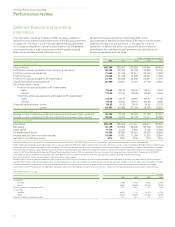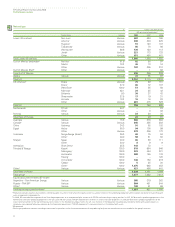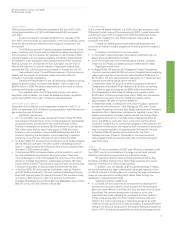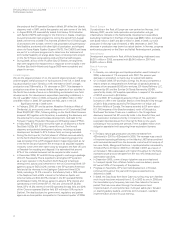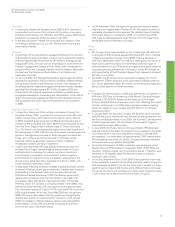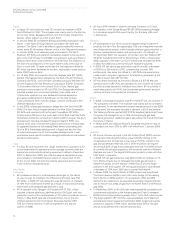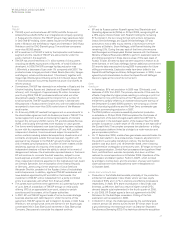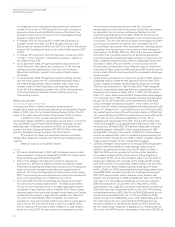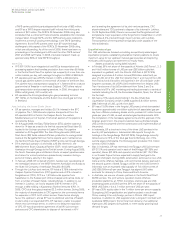BP 2008 Annual Report Download - page 20
Download and view the complete annual report
Please find page 20 of the 2008 BP annual report below. You can navigate through the pages in the report by either clicking on the pages listed below, or by using the keyword search tool below to find specific information within the annual report.
Performance review
BP Annual Report and Accounts 2008
Performance review
All the group’s oil and gas reserves held in consolidated companies have
been estimated by the group’s petroleum engineers. Of the equity-
accounted volumes in 2008, 18% were based on estimates prepared by
group petroleum engineers and 82% were based on estimates prepared
by independent engineering consultants, although all of the group’s oil
and gas reserves held in equity-accounted entities are reviewed by the
group’s petroleum engineers before making the assessment of volumes
to be booked by BP.
Our proved reserves are associated with both concessions (tax
and royalty arrangements) and agreements where the group is exposed
to the upstream risks and rewards of ownership, but where title to the
hydrocarbons is not conferred, such as production-sharing agreements
(PSAs). In a concession, the consortium of which we are a part is entitled
to the reserves that can be produced over the licence period, which may
be the life of the field. In a PSA, we are entitled to recover volumes that
equate to costs incurred to develop and produce the reserves and an
agreed share of the remaining volumes or the economic equivalent.
As part of our entitlement is driven by the monetary amount of costs to
be recovered, price fluctuations will have an impact on both production
volumes and reserves. Sixteen per cent of our proved reserves are
associated with PSAs. The main countries in which we operate under
PSAs are Algeria, Angola, Azerbaijan, Egypt, Indonesia and Vietnam.
We separately disclose our share of reserves held in equity-
accounted entities (jointly controlled entities and associates), although
we do not control these entities or the assets held by such entities.
Resource progression
BP manages its hydrocarbon resources in three major categories:
prospect inventory, non-proved resources and proved reserves. When a
discovery is made, volumes usually transfer from the prospect inventory
to the non-proved resource category. The resources move through
various non-proved resource sub-categories as their technical and
commercial maturity increases through appraisal activity.
Resources in a field will only be categorized as proved reserves
when all the criteria for attribution of proved status have been met,
including an internally imposed requirement for project sanction or for
sanction typically expected within six months and, for additional reserves
in existing fields, the requirement that the reserves be included in the
business plan and scheduled for development, typically within three
years. Where, on occasion, the group decides to book reserves where
development is scheduled to commence after three years, these
reserves will be booked only where they satisfy the SEC’s criteria for
attribution of proved status. Internal approval and final investment
decision are what we refer to as project sanction.
At the point of sanction, all booked reserves will be categorized as
proved undeveloped (PUD). Volumes will subsequently be recategorized
from PUD to proved developed (PD) as a consequence of development
activity. When part of a well’s reserves depends on a later phase of
activity, only that portion of reserves associated with existing, available
facilities and infrastructure moves to PD. The first PD bookings will occur
at the point of first oil or gas production. Major development projects
typically take one to four years from the time of initial booking of PUD
reserves to the start of production. Changes to reserves bookings may
be made due to analysis of new or existing data concerning production,
reservoir performance, commercial factors, acquisition and divestment
activity and additional reservoir development activity.
Governance
BP’s centrally controlled process for proved reserves estimation approval
forms part of a holistic and integrated system of internal control. It
consists of the following elements:
• Accountabilities of certain officers of the group to ensure that there is
review and approval of proved reserves bookings independent of the
operating business and that there are effective controls in the approval
process and verification that the proved reserves estimates and the
related financial impacts are reported in a timely manner.
• Capital allocation processes, whereby delegated authority is exercised
to commit to capital projects that are consistent with the delivery of
the group’s business plan. A formal review process exists to ensure
that both technical and commercial criteria are met prior to the
commitment of capital to projects.
• Internal Audit, whose role includes systematically examining the
effectiveness of the group’s financial controls designed to assure the
reliability of reporting and safeguarding of assets and examining the
group’s compliance with laws, regulations and internal standards.
• Approval hierarchy, whereby proved reserves changes above certain
threshold volumes require central authorization and periodic reviews.
The frequency of review is determined according to field size and
ensures that more than 80% of the BP reserves base undergoes
central review every two years and more than 90% is reviewed every
four years.
For the executive directors and senior management, no specific portion
of compensation bonuses is directly related to oil and natural gas
reserves targets. Additions to proved reserves is one of several indicators
by which the performance of the Exploration and Production segment
is assessed by the remuneration committee for the purposes of
determining compensation bonuses for the executive directors. Other
indicators include a number of financial and operational measures.
BP’s variable pay programme for the other senior managers in the
Exploration and Production segment is based on individual performance
contracts. Individual performance contracts are based on agreed items
from the business performance plan, one of which, if chosen, could
relate to oil and gas reserves.
Reserve replacement
Total hydrocarbon proved reserves, on an oil equivalent basis and
excluding equity-accounted entities, comprised 12,562mmboe at
31 December 2008, a decrease of 0.2% compared with 31 December
2007. Natural gas represents about 55% of these reserves. The decrease
includes a net decrease from acquisitions and divestments of 169mmboe,
largely comprising a number of assets in Venezuela and the US.
Total hydrocarbon proved reserves, on an oil equivalent basis
for equity-accounted entities alone, comprised 5,585mmboe at
31 December 2008, an increase of 6.8% compared with 31 December
2007. Natural gas represents about 16% of these proved reserves. The
increase includes a net increase from acquisitions and divestments of
199mmboe, largely comprising a number of assets in Venezuela.
The proved reserves replacement ratio (also known as the production
replacement ratio) is the extent to which production is replaced by proved
reserves additions. This ratio is expressed in oil equivalent terms and
includes changes resulting from revisions to previous estimates,
improved recovery and extensions and discoveries, and may be
expressed as a replacement ratio excluding acquisitions and divestments
or as a total replacement ratio including acquisitions and divestments.
BP estimates proved reserves for reporting purposes in
accordance with SEC rules and relevant guidance. As currently required,
these proved reserve estimates are based on prices and costs as of the
date the estimate is made. There was a rapid and substantial decline in
oil prices in the fourth quarter of 2008 that was not matched by a similar
reduction in operating costs by the end of the year. BP does not expect
that these economic conditions will continue. However, our 2008
reserves are calculated on the basis of operating activities that would be
undertaken were year-end prices and costs to persist.
Performance review
19



